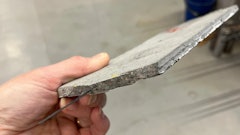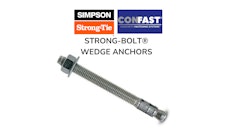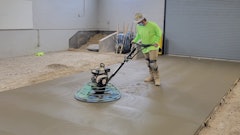
For 100 years, the Panama Canal has stood as a testament to the ingenuity and engineering marvels of the 20th century. However, the time has come for the Panama Canal to undergo an expansion by adding a third shipping lane to accommodate larger shipping vessels. Construction on the third set of locks has been ongoing since September 2007 and of course, concrete and concrete accessories are the shining stars.
The new set of locks is intended to double the capacity of the Panama Canal by creating a new lane of traffic and allowing larger ships to transit “Post Panamax” — which is the term coined for the size limits of ships traveling through the canal.
The expansion project is estimated to cost from $5.25 billion to $7 billion, and has led to heavy investment in the construction sector of Panama, as well as the development of new infrastructure in Panama City. The contractor responsible for building the third set of locks is Grupo Unidos Por El Canal (GUPC), a business consortium led by SACYR VALLEHERMOSO, Spain; Impreglio, Italy; Jan de Nul, Belgium and CUSA, Panama.
Summary of the project
The Panama Canal Expansion Project consists of two new locks, one each on the Atlantic and Pacific sides. Each will feature water-saving basins intended to reduce the environmental impact. The existing channels will be widened and deepened to raise the maximum operating level of Gatun Lake, which serves as the conduit between the Pacific and Atlantic coasts.
Incidentally, Gatun Lake was artificially created in 1913 by the damming of the Chagres River, and is an essential part of the Panama Canal which forms a water passage between the Atlantic and Pacific Oceans, permitting ships to transit in both directions. At the time it was formed, Gatun Lake was the largest man-made lake in the world. Gatun Lake also serves to provide the millions of gallons of water necessary to operate the Panama Canal locks each time a ship passes through, and provides drinking water for Panama City and Colón.
When the canal is completed, the new shipping lanes are expected to generate increased demand in ports both in Panama and internationally.
Water basins will be used to recycle water
The new canal will operate in a more environmentally friendly fashion, specifically as it relates to water consumption.
Once completed, the water basins will be the largest in the world. The basins are designed to reuse up to 60 percent of the water consumed by the locks. Gatun Lake is not only utilized as a conduit to connect the Atlantic side with the Pacific side of Panama, but it also serves as Panama’s drinking water source. As one can imagine, during the rainy season in Panama, water levels in the lake are monitored, but rarely pose a threat to a diminishing water source. However, during the non-rainy season, a water shortage is a realistic threat to the community. To address this ongoing threat, located on the side of the canal will be man-made water basins designed to recycle and reuse the water from the canal. Chambers were constructed to help transfer the water back and forth between the canal and the lake.
“The water draining into Gatun Lake is a big problem,” says Alex Sanchez, project site supervisor with GUPC. “When it isn’t raining there are water shortages. The water levels in the lake can’t get below a certain level otherwise the shipping vessels can’t pass through. We don’t get the option to run out of water in the lake because it will also cut off the canal.”
The practice of dumping millions of gallons of fresh water everyday into the ocean is not sustainable. “Recycling the water from the canal is the right thing to do and a thing of necessity because Gatun Lake cannot sustain two canals and be a water source for Panama.”
The design of the water basins features a fill and drain system. The raising and lowering of the canal to facilitate passage through the canal will be operated in three stages over three chambers — low, medium and high. In order to limit the amount of water wasted, the new system will allow larger ships to pass through the canal, using up to seven percent less water than the existing locks.
Each chamber will feature three water-saving basins, for a total of nine basins per lock. Just like the existing locks, the new locks and their basins will be filled and emptied by gravity, without the use of pumps . “The water they use to fill in the locks will be the same water that will come back into the recycling pool,” explains Sanchez.
Originally scheduled to open around the 100th anniversary of the first canal, August 2014, budget overruns have delayed the project to a January 2016 opening.
By the year 2025, the expanded Panama Canal is expected to bring $6.2 billion to the Panamanian government.
Taking a tour of the site
As one can imagine, the jobsite on this project is massive: a machine shop, an aggregate processing plant and a concrete batch plant are located on site. Everything needed to construct the canal walls is readily available.
The workshop is where all the bending of rebar is performed. At the time of this writing, the project was approximately 70 percent complete and the demand for rebar has diminished. However, at the beginning of the project, there were three machines set up to thread rebar. To date, crews have unloaded 105,000 tons of steel and have used 86,000 tons.
“The project plans required us to thread the ends of three different sizes of rebar — No. 4, No. 6 and No. 8,” says Sanchez. “We had one specific machine set up for each size of rebar. Now we have all three machines set up for the No. 4 rebar.”
The steel is sourced from Mexico and Costa Rica and arrives on site, pre-cut and figured for a location. However, plans can and do change. Sanchez says, “Due to circumstances in the field and because all of the steel is configured to our needs, we cannot rebend any rebar if changes occur. That rebar becomes unusable. It will be sold back to our steel supplier, melted down and recycled for reuse.”
Aggregate processing plant
Colon, Panama is home to the expansion project on the Atlantic Ocean side and because of its remote location, crews assembled an aggregate processing plant on site. The crushing of aggregate begins near the shores of Gatun Lake. It is here, where barges deliver aggregate, starting the journey through various conveyor belt systems.
“The aggregate arrives as large rocks,” Sanchez says. “As it is being processed, it is distributed to various points on the plant. Different lanes break the rock down into different sizes. In fact, this plant produces nine different sizes of aggregate.” All the conveyors run underground to its final destination before being segregated by size.
“Just as there are multiple sizes of aggregate, there are also six different sizes of sand fine aggregates created for concrete mixes,” he adds.
Concrete admixture
The concrete batch plant, engineered and manufactured by Italy’s SIMEM, is designed to process approximately 797.85 cubic yards (610 cubic meters) per hour with dedicated scales to handle the aggregate types required for the admixture.
Project engineers determine what types of aggregate should be used to create the required mixes. “While it’s not common to have this many different sizes of aggregate,” Sanchez says, “the specifications called for the different sizes to create the well-graded dense marine concrete mixes.”
The Marine mix is a special mix design used for any part of the locks that comes into contact with water. In addition to compressive strength and reduced shrinkage, the low permeable concrete had to be formulated to guarantee a 100-year service life.
The new locks are being constructed using two different concrete mix designs, a Structural Marine Concrete (SMC) and an Interior Mass Concrete (IMC). A typical concrete section consists of an IMC core with SMC facing. The SMC facing is typically 24-inches thick while the IMC varies. A lock wall monolith is approximately 60-feet wide, 100-feet high and 95-feet long. Each lock wall monolith contains two 20-foot tall culverts for filling and draining the chamber. The monoliths require 232-tons of reinforcing steel and 3,400 cubic yards of concrete each. A total of about 50 of these massive concrete structures make up each lock chamber.
The foundations for the locks are mass concrete. This mix includes Portland cement, fly ash (or other pozzolans), aggregate size from 1-1/2” to 3” and reduced amounts of water. While the mix is curing, temperatures may not exceed 160-degrees Fahrenheit, nor have more than a 30-degree Fahrenheit differential between the center of a placement and the outside surface. The high temperatures in Panama pose additional challenges to preventing thermal cracking. Temperature is reduced by covering the aggregate piles with large tents for sun protection. At the start of the batching process, water cools the aggregate on its way to the bin, which is a fully enclosed, air-conditioned area. In addition, flake ice is placed on the main feed conveyor with the aggregate. Conveyor belt systems are then used to pull the underground material to a final batch mixing stage.
Pouring the canal walls
More than 5 million cubic meters of low slump concrete have been placed to date to create the canal walls. Transporting the concrete to the placing sites was a challenge in itself.
A fleet of agitator trucks transport the mix from the concrete batch plant to locations throughout the jobsite. For large placements at key locations, conveyors and concrete pumping systems are set up on the floor of the canal. The contractor uses Putzmeister 38-meter pumps and, five section TB130 telescopic belt conveyors to place the concrete into wall sections.
For the most hard-to-reach sections of the canal, concrete Schwing and Putzmeister trucks with attached boom pumps are used. In addition, four Rotec tower-crane mounted conveyors with an 80 meter reach are used.
Dayton Superior provides jobsite solutions
In order to structurally join rebar together GUPC opted to utilize Dayton Superior’s Mechanical Couplers Taper lock system. Additionally, Dayton’s Taper Lock Flange Couplers were used in order to avoid having to use chemical anchored rebar for future, segmental concrete pours. Over 500,000 of these couplers will be used throughout the jobsite.
The contractor is also using Dayton Superior’s EZ Lock Spacer Wheel system to provide the correct rebar spacing from concrete surfaces as required by the engineer. Because the concrete in the Panama Canal is constantly exposed to salt and fresh water, the spec required the rebar be kept far enough away from the concrete surface to reduce exposure that could cause corrosion. The spacer wheels enabled the contractor to maintain the right amount of concrete coverage in walls that exceeded 100 feet in height with wall thicknesses that varied from 4-1/2 in., 5-1/2 in., and 6-1/2 in. thicknesses.
One of the contractor’s options was to manufacture concrete dobies. But the areas for properly spacing rebar were extremely large and it would be impossible to attach a concrete block with the required coverage areas on a vertical application.
Dayton Superior was one of only three companies consulted on the solution and the EZ Lock Spacer Wheel system was selected due to characteristics such as strength and the lock hub. Additionally, laborers on site were now able to install spacer wheels faster and ensure the coverage area would be correct for the construction inspections conducted on each aspect of the project.
“We manufactured the EZ Lock Spacer Wheels in the USA and supplied them through our local Dayton Superior distribution center in Panama City,” says Rick Wilson, Regional Vice President – Latin America. “Dayton Superior’s local facility gave us the advantages as there were only two other companies worldwide that could custom make these products. The spacer wheel proved superior because once locked onto the rebar they would not fall off or change shape, guaranteeing uniform coverage.”
Another benefit to using the custom spacer wheels is that the concrete did not require sanding for a smooth finish, saving labor costs and work time.
Once the project is complete, over 300,000 of these units will have been installed.
As construction of the canal walls progressed and the concrete pours were set up in phases, the couplers were installed during the first stage of the pour to mechanically splice structural reinforcement. “Workers mechanically splice into the couplers which can be seen imbedded in the first stage pour,” notes Danny Hernandez, Sales Manager – Latin America (Dayton Superior).
Plan changes during the construction of the canal have occasionally created challenges for the contractor. For example, Sanchez describes one instance, “The first stage of the design plans tell us where we need to install the couplers. However, once the first stage pour was completed, we moved into the second stage pour and there were some structural changes made where we could not use Dayton’s couplers, but they had already been embedded into the first stage pour. We couldn’t move the coupler. In order to make a structural connection, we used an anchoring epoxy from HIlti to make the connection.”
Conclusion
A lot has changed since the original construction of the Panama Canal. Modern construction machines, amazing technology, and huge strides in the production of concrete make this project vastly different than the struggle to build the first one. But this project is one of the world’s great construction marvels and is by no means a walk in the park — challenges abound. To the average person the price tag might seem to be a lot, but that’s about what it costs to build a high end casino in Las Vegas these days — the forces of nature being much easier to deal with.




























